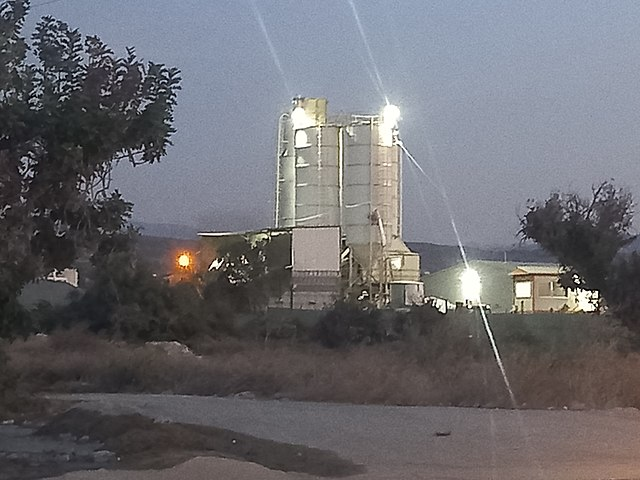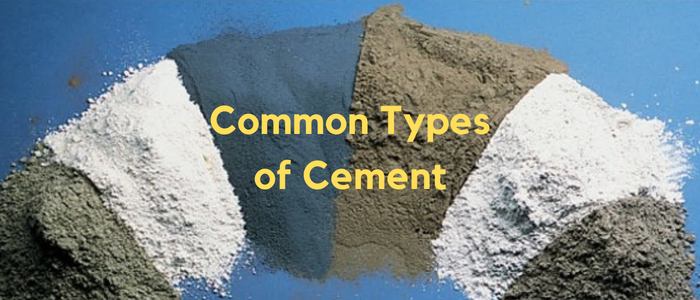Common Cement Types in Concrete Industry
Common Cement Types: In concrete production, there are multiple kinds of cements that can be implemented, depending on the specific conditions you may have in the project and the required properties of concrete.
The difference in cement types come from the raw materials, method of production and the treatment of the produced cement.
Each type of cement has its own applications and uses.
Names of the common cement types
- Ordinary Portland Cement (OPC)
- Portland Pozzolanic Cement
- Low Heat Cement
- Rapid Hardening Cement
- High Alumina Cement
- Sulfates Resisting Cement
- White Cement
Ordinary Portland Cement (OPC)
Ordinary cement, Portland cement, general use cement, OPC are all names that refer to the same thing which is ordinary Portland cement. OPC is the most widely used in construction industry. It is a general-purpose type of cement, which means we use it in any application that does not require special requirements.
Lafarge, which is one of the biggest concrete production companies, defines OPC as “a general-purpose Portland cement suitable for all uses where the special properties of other types are not required. It is used where cement or concrete is not subject to specific exposures, such as sulfate attack from soil or water, or to an objectionable temperature rise due to heat generated by hydration. Its uses include pavements and sidewalks, reinforced concrete buildings, bridges, railway structures, tanks, reservoirs, culverts, sewers, water pipes and masonry units.”
Between 4 and 4.5 billion tonnes of hydraulic cement are anticipated to be produced year, up from the 4.07 billion tonnes produced in 2013. With a population of 1.42 billion, China is predicted to be the top global producer, accounting for more than half of all concrete production worldwide. When one tonne of CO2 is generated in the production of one tonne of OPC, the cement sector comes in front with 6% of total CO2 emissions.

Portland Pozzolanic Cement
Pozzolanic cement is a type of cement (usually OPC) that includes pozzolanic materials as an ingredient. Pozzolanic materials are added to cement during the grinding of clinker. Pozzolanic cement can also be added during the addition of gypsum to cement or just by blending the ordinary cement with a fine pozzolanic material before or during the mixing of concrete.
Pozzolanic cement = cement (can be any type but usually OPC) + pozzolanic material
Of course, the addition of pozzolanic materials such as fly ash, slag and silica fume provides the resulting concrete with enhanced properties compared to the normal concrete. This makes pozzolanic cement more suitable for use in special environments such as marine conditions, sewage works, and so on.
A pozzolan is a siliceous or siliceous and aluminous substance that, by itself, has little to no cementitious value. However, when it is finely fragmented and exposed to moisture, it chemically reacts with calcium hydroxide at room temperature to produce compounds with cementitious qualities. As a result, it is categorised as cementitious material.
Finely divided siliceous or aluminous compounds react with calcium hydroxide to create cementitious materials that are very stable and have a complex composition that includes calcium, silica, and water. Amorphous silicate often responds more faster than crystalline silicate. The reaction of pozzolanic materials transforms calcium hydroxide, a water-soluble substance, into an insoluble cementitious material.
The pozzolanic reaction initially proceeds slowly, which also affects the generation of hydration heat and the growth of strength. There is no synthesis of Ca(OH)2 since the reaction includes the consumption of Ca(OH)2. By making the cement paste solid and impenetrable, the lowering of Ca(OH)2 boosts cement paste’s durability.
Low Heat Cement
Low heat cement, as the name implies, emits less heat compared to the normal cement. The heat we are talking about is the heat during hydration process which starts once cement gets into contact with water.
So, what is the compound of cement that we alter to get the low heat cement?
The answer is three compounds (C3S, C2S and C3A). We can alter one or more of these compounds. This low heat evaluation is achieved by reducing of contents of C3S and C3A, which are compounds releasing the maximum amount of heat of hydration during the process and increasing C2S.
Since this type of cement reduces the heat generation, the chemical reaction also is retarded, which in turn gives lower rate of heat generation. This means the evolution of heat will happen over an extended period of time.
Accordingly, the slow rate of strength increase is the primary characteristic of low heat cement.
The properties of low heat cement make it suitable for use in mass concrete, which is in structures that uses massive amounts of concrete such as dams. Thus, when you reduce the heat generation in mass concrete, you prevent the formation of heat cracks in the concrete.
There is another benefit for this type of cement because of the less C3A amount, which the higher resistance to sulfate attack compared to OPC.
Rapid Setting Cement
This type of cement that has a property of rapid setting and hardening when contacts water. The rapid setting gives high early strength because of the rapid hydration and setting. This cement is suitable for use when high early strength is needed or there is a requirement to remove the formwork at an early stage.
You can say that the 3-days strength of rapid setting cement is approximately equivalent to the 7-days strength of ordinary cement when other factors are constant.
So, we can obtain rapid setting cement by doing multiple things. For example, we can increase the C3S and C3A contents or reduce C2S . Also, we can increase the fineness of cement.
Typical applications for rapid setting cement are repair works, road works and precast concrete.
High Alumina Cement
High Alumina Cement, or abbreviated as HAC, is also called as calcium aluminum cement and one the common cement types. High Alumina Cement is made of limestone and bauxite. (Bauxite is a residual deposit formed by the weathering of rocks which have high aluminum content).
Limestone is ground with the bauxite and then the resulting dry mix enters the kiln. The kiln has a temperature of 1600 oC which cause melting of the mix (the melting process is called fusion).
Molten clinker is allowed to cool down and forms granulated material. Clinker is then ground and mixed with gypsum until reaching the required fineness of cement.
Sulfate Resistant Cement
This type of cement is meant to be highly resistant to sulfate attack.
Concrete is vulnerable to sulphate attack in some situations. These include sulfate-rich soils and groundwater, some industrial settings, seawater, and sanitary sewers. Gypsum, which can be a cause of internal sulphate attack, is present in several aggregates.
Sulfate ions react with the Portland cement hydration by-products regardless of their source. The tricalcium aluminate hydration product, or C3A in cement chemistry notation, is the essential element in the process. Monosulfate is created when C3A hydrates. Sulfates are present in cement to regulate setting. Before the concrete hardens, they combine with the monosulfate to create ettringite.
Thus, we can obtain sulfate-resisting cement by reducing the amount of C3A in cement, typically below 5%.
White Cement
Except for colour, white portland cement and grey cement largely have the same characteristics.
The color of white cement is determined by its raw materials and the manufacturing process. Metal oxides, primarily iron and manganese, influence the whiteness and undertone of the material. Thus, decreasing these compounds in cement will give the whiteness of cement.
White cements generate clear, vivid colours when pigments are added, especially for light pastels. Concrete may be coloured in a variety of ways, and much like with paint, various hues can be made by mixing two or more pigments. By altering the surface finish treatment or texture and using coloured aggregates, an even wider range of decorative appearances may be produced.
Common Cement Types —> Read Also: Types of Concrete Admixtures
